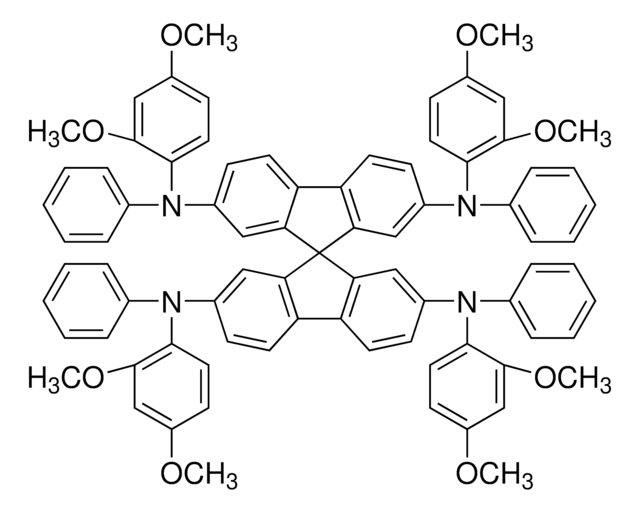792071
Spiro-MeOTAD
99% (HPLC)
Synonyme(s) :
N2,N2,N2′,N2′,N7,N7,N7′,N7′-octakis(4-methoxyphenyl)-9,9′-spirobi[9H-fluorene]-2,2′,7,7′-tetramine, Spiro-OMeTAD
About This Item
Produits recommandés
Pureté
99% (HPLC)
Forme
solid
Caractéristiques du produit alternatif plus écologique
Design for Energy Efficiency
Learn more about the Principles of Green Chemistry.
sustainability
Greener Alternative Product
Pf
243-248 °C
λmax
306 nm in dichloromethane
385 nm in dichloromethane
Fluorescence
λem 429 nm in dichloromethane
Autre catégorie plus écologique
, Enabling
Chaîne SMILES
COC(C=C1)=CC=C1N(C2=CC=C(C=C2)OC)C(C=C3)=CC4=C3C(C=CC(N(C5=CC=C(C=C5)OC)C6=CC=C(C=C6)OC)=C7)=C7C84C9=C(C=CC(N(C%10=CC=C(C=C%10)OC)C%11=CC=C(C=C%11)OC)=C9)C%12=C8C=C(N(C%13=CC=C(C=C%13)OC)C%14=CC=C(C=C%14)OC)C=C%12
InChI
1S/C81H68N4O8/c1-86-65-29-9-53(10-30-65)82(54-11-31-66(87-2)32-12-54)61-25-45-73-74-46-26-62(83(55-13-33-67(88-3)34-14-55)56-15-35-68(89-4)36-16-56)50-78(74)81(77(73)49-61)79-51-63(84(57-17-37-69(90-5)38-18-57)58-19-39-70(91-6)40-20-58)27-47-75(79)76-48-28-64(52-80(76)81)85(59-21-41-71(92-7)42-22-59)60-23-43-72(93-8)44-24-60/h9-52H,1-8H3
Clé InChI
XDXWNHPWWKGTKO-UHFFFAOYSA-N
Description générale
Application
Code de la classe de stockage
11 - Combustible Solids
Classe de danger pour l'eau (WGK)
WGK 3
Point d'éclair (°F)
Not applicable
Point d'éclair (°C)
Not applicable
Certificats d'analyse (COA)
Recherchez un Certificats d'analyse (COA) en saisissant le numéro de lot du produit. Les numéros de lot figurent sur l'étiquette du produit après les mots "Lot" ou "Batch".
Déjà en possession de ce produit ?
Retrouvez la documentation relative aux produits que vous avez récemment achetés dans la Bibliothèque de documents.
Les clients ont également consulté
Articles
Solar panel demand surges for sustainable energy, with power output rising from 5.0 to 90 GWh/d from 2010 to 2016.
Explore the eco-friendly potential of organic thin film transistors (OTFTs) for detecting chemical analytes, identifying viruses, and assisting in health diagnostics. This mini-review highlights challenges of achieving sustainability, safety, and biodegradability of each component of an OTFT sensor.
While dye sensitization as the basis for color photography has been accepted for a very long time,1 attempts to use this principle for the conversion of solar light to electricity generally had resulted only in very low photocurrents, below 100 nA/cm
Next generation solar cells have the potential to achieve conversion efficiencies beyond the Shockley-Queisser (S-Q) limit while also significantly lowering production costs.
Contenu apparenté
L'électronique organique utilise des conducteurs et des semiconducteurs organiques pour les applications du type cellules photovoltaïques organiques, diodes électroluminescentes organiques (OLED) et transistors à effet de champ organiques (OFET).
Organic electronics utilizes organic conductors and semiconductors for applications in organic photovoltaics, organic light-emitting diodes, and organic field-effect transistors.
Notre équipe de scientifiques dispose d'une expérience dans tous les secteurs de la recherche, notamment en sciences de la vie, science des matériaux, synthèse chimique, chromatographie, analyse et dans de nombreux autres domaines..
Contacter notre Service technique









